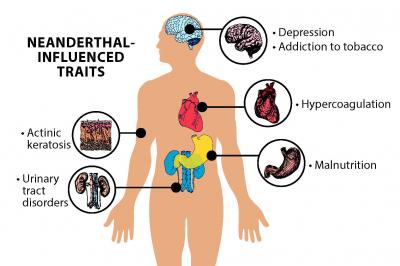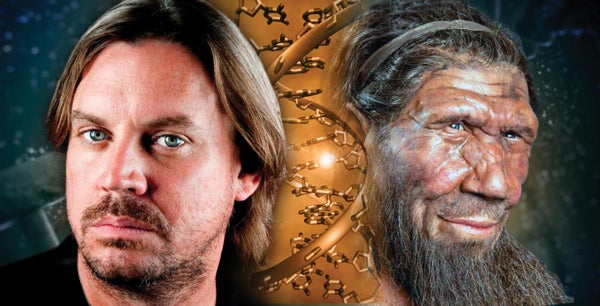Ancient trysts between Neanderthals and modern humans may have influenced modern risks for depression, heart attacks, nicotine addiction, obesity and other health problems, researchers said.
The Neanderthals were once the closest relatives of modern humans. Scientists recently discovered that Neanderthals and modern humans once interbred; nowadays, about 1.5 to 2.1 percent of DNA in people outside Africa is Neanderthal in origin.
"This raises several fascinating questions like, 'What effect does the Neanderthal DNA that remains in modern humans have on our biology?'" said study senior author John Capra, an evolutionary geneticist at Vanderbilt University in Nashville. [See Photos of Our Closest Human Ancestor]
On supporting science journalism
If you're enjoying this article, consider supporting our award-winning journalism by subscribing. By purchasing a subscription you are helping to ensure the future of impactful stories about the discoveries and ideas shaping our world today.
Now, for the first time, researchers have directly compared Neanderthal DNA with the clinical records of a significant portion of adults of European ancestry. The scientists discovered that this archaic genetic legacy has had a subtle but significant impact on modern human biology, they said.
"Neanderthal DNA influences a broad range of traits relevant to disease risk in modern humans," Capra told Live Science.
The researchers first identified about 135,000 Neanderthal genetic variations found in modern humans. Next, the scientists analyzed a database of more than 28,000 adults of European ancestry from the Electronic Medical Records and Genomics (eMERGE) Network, a consortium of nine hospitals across the United States. This data linked patient genetic data with versions of those individuals' electronic health records that were stripped of identifying details such as names and addresses.
The data helped the researchers determine if each person had ever been treated for medical conditions such as heart disease, arthritis and depression. It also helped the scientists determine what Neanderthal genetic variants each person carried.

This graphic shows Neanderthal-influenced traits.
Credit: Deborah Brewington, Vanderbilt University
Ultimately, the researchers found that Neanderthal genetic variants were significantly linked to increased risk of 12 traits, including heart attack and artery thickening.
Surprisingly, the investigators also found a Neanderthal genetic variant that significantly increased the modern human risk for nicotine addiction, the researchers said. However, this does not mean that Neanderthals smoked tobacco, Capra said.
"Tobacco was found solely in the Western Hemisphere until Europeans brought it back from expeditions to the Americas," Capra said. The Neanderthal DNA that boosts the risk of nicotine addiction may have had a completely different and potentially beneficial effect "that exhibited itself 50,000 years ago," Capra said.
Some of the scientists' discoveries confirm previous ideas. For example, earlier research suggested that Neanderthal DNA influenced skin cells known as keratinocytes that help protect the skin from environmental damage such as ultraviolet radiation and germs. The new findings suggest that Neanderthal genetic variants increase the risk of developing sun-triggered skin lesions known as keratoses, which are caused by abnormal keratinocytes.
"When we started this study, we expected that if we found anything at all, we would find an influence of Neanderthal DNA on bodily systems that are involved in interactions with the environment," Capra said. "We hypothesized this because Neanderthals had been living in Central Asia and Europe for hundreds of thousands of years before our recent ancestors ever reached these areas—and thus had likely adapted to the distinct environmental aspects of these regions, compared to Africa, in terms of climate, plants and animals, and pathogens."
Capra and his colleagues also found that a number of Neanderthal genetic variants influenced the risk for depression, with some variants increasing the risk and others reducing it.
"The brain is incredibly complex, so it's reasonable to expect that introducing changes from a different evolutionary path might have negative consequences," study lead author Corinne Simonti, a graduate student of human genetics at Vanderbilt University, said in a statement."
The researchers suggest that some Neanderthal genetic variants might have provided benefits in modern human populations as they first moved out of Africa thousands of years ago. However, those variants may have later become detrimental in modern, Western environments, the scientists said. One example is Neanderthal DNA that increases blood clotting; while this can help seal wounds and prevent germs from entering the body, it can also increase the risk for stroke, miscarriage and other problems, Capra said.
The researchers suggest that Neanderthal DNA may not have contributed to differences in skin colors between modern humans, unlike what previous research has suggested. Instead, differences in modern human skin color probably developed very recently, Capra said. "Neanderthals may also have had a range of skin colors," Capra added.
Future research can compare Neanderthal DNA with data gleaned from other sources of medical information, such as lab tests, doctors' notes and medical images, the researchers said. "There is still much to learn about the effects of interbreeding on different populations in recent human history," Capra said.
The scientists detailed their findings online today (Feb. 11) in the journal Science.
Copyright 2016 LiveScience, a Purch company. All rights reserved. This material may not be published, broadcast, rewritten or redistributed.
